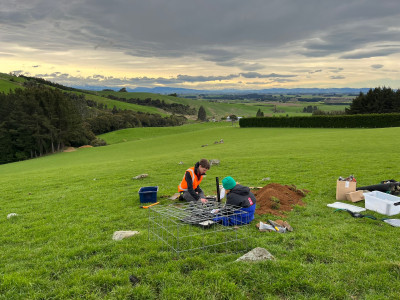Researcher profile: Dr Jack Williams
We might think of the southeastern South Island as an unlikely place to get earthquakes, but the reality is, it’s still at higher chance compared to many parts of the world.
Traditionally, earthquakes in Southland and Otago have been understudied. The reason is two-fold: a lack of earthquakes means there is a lack of data to study, and resources tend to focus on regions of high seismic activity. But, as we’ve seen from Christchurch, earthquakes do strike in areas of low seismic activity where they can have devastating impacts.
Dr Jack Williams is part of a group of researcher championing earthquake research in New Zealand’s “forgotten regions”. He’s a postdoctoral research fellow in Professor Mark Stirling’s group at the University of Otago.
Funded by Natural Hazard Commission Toka Tu Ake, Jack recently completed a study into prehistoric earthquakes in Southland to better understand where future earthquakes might happen.
We talked to Jack as part of our monthly Researcher Profile series.
Tell us a little bit more about your project.
I work on one of the first research projects to specifically investigate seismic hazard and risk in Aotearoa New Zealand’s ‘low seismicity zones.’ Typically, earthquake research is invested in regions close to major plate-boundary faults where future earthquakes are most likely. However, as the Canterbury Earthquake Sequence showed, we have significant knowledge gaps with managing seismic risk in low seismicity zones. My research focusses on examining the spatial-temporal distribution of earthquakes in Southland using techniques such as temporary seismometer deployments and excavating trenches across geologic faults. This research will help us develop better earthquake forecasts in low seismicity regions across the motu, including regions like Waikato and Auckland.
Why is it important to invest in natural hazards research like yours?
As recognised by the UN Sendai Framework, it is a far more effective use of resources to invest in increased preparedness than in just dealing with the post-disaster recovery. Indeed, recent earthquakes, such as the 2023 M 7.8 Turkey-Syria Earthquake, and 2024 M 7.4 Hualien Earthquake in Taiwan, show that the loss associated with these events is not just dictated by the earthquake itself, but also by how we as a society prepare for them. By investing in earthquake hazard research, we can constrain the size and frequency of earthquakes at a given locality and then plan accordingly. This means that when earthquakes inevitably occur, we can be resilient to their consequences.
What is your vision for a resilient New Zealand – what does it mean and look like?
I hope our research highlights that damaging earthquakes can occur in places such as Auckland, Hamilton, and Dunedin, where, because there haven’t been many historical earthquakes, the seismic hazard is perceived to be negligible. However, I am also well aware that my earthquake hazard research is only one component to building resilience. Achieving this will partly come from high-level institutions. However, I also believe that resilience means recognising that we all have our part to play, and small actions at an individual level (e.g., having an earthquake preparedness kit) can go a long way to determining the outcome of these events.
What’s your favourite natural hazards fun fact?
We can estimate that a very large earthquake occurred off the northwest coast of the United States on 26th January 1700 (around about 9 pm local time) even though there is no written historical evidence of this event in North America. How? From records of the tsunami that this earthquake generated arriving in Japan!